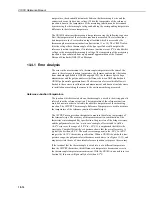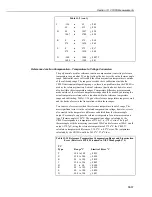
Section 13. CR10X Measurements
13-3
In order to make a differential measurement, the inputs must be within the CR10X
common mode range of ±2.5V. The common mode range is the voltage range,
relative to CR10X ground, within which both inputs of a differential measurement
must lie in order for the differential measurement to be made. For example, if the
high side of a differential input is at 2V and the low side is at 1V relative to
CR10X ground, there is no problem; a measurement made on the +2.5V range
would indicate a signal of 1V. However, if the high input is at 2.8V and the low
input is at 2V, the measurement cannot be made because the high input is outside
the common mode range. The CR10X indicates the overrange by displaying
-99999.
Problems with exceeding common mode range may be encountered when the
CR10X is used to read the output of external signal conditioning circuitry if a
good ground connection does not exist between the external circuitry and the
CR10X. When operating where AC power is available, it is not always safe to
assume that a good ground connection exists through the AC wiring. If a CR10X
is used to measure the output from a laboratory instrument (both plugged into AC
power and referencing ground to the AC outlet ground), it is best to run a ground
wire between the CR10X and the external circuitry. Even with this ground
connection, the ground potential of the two instruments may not be at exactly the
same level, which is why a differential measurement is preferable.
If a differential measurement is used on a sensor that is not referenced to CR10X
ground through a separate connection (e.g. a net radiometer), a jumper wire
should be connected between the low side of the differential input and ground to
hold the sensor signal inside the common mode range.
A differential measurement has better noise rejection than a single-ended
measurement. Integrating the signal in both directions also reduces input offset
voltage due to thermal effects in the amplifier section of the CR10X. The input
offset voltage on a single-ended measurement is less than 5
µ
V; the input offset
voltage on a differential measurement, however, is less than 1
µ
V.
A single-ended measurement is quite satisfactory in cases where noise is not a
problem and care is taken to avoid ground potential problems. Channels are
available for twice as many single-ended measurements. A single-ended
measurement takes about half the time of a differential measurement, which is
valuable in cases where rapid sampling is a requirement.
Sustained voltages in excess of +16V DC applied to the
analogue inputs will damage the CR10X input circuitry.
13.2.1 Effect of Continuously Powered Sensors on Single-Ended
Thermocouples
Some sensors connected to the datalogger need to be permanently powered. For
example, (a) where the power consumption is so low that it can be ignored and
(b) where the sensor generates an analogue signal that requires a fast sampling rate
and so prevents the power being switched on and off between measurements..
For greatest accuracy, single-ended sensors of this type are normally connected to
the AG terminal for power return. However, the resultant current flow into AG,
even if very small, will affect the accuracy of measurements from single-ended
thermocouples.
CAUTION
















































